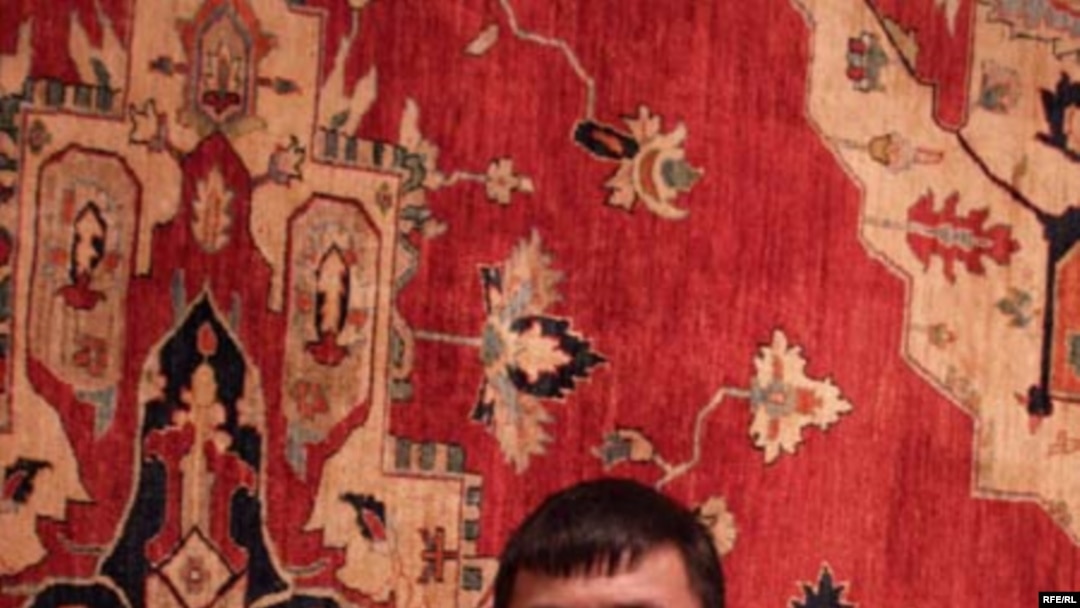But their struggle has not been easy and continues today because their homeland remains a difficult place to do business -- forcing most of the Afghan production houses to remain in Pakistan and operate under Pakistani regulations.
A Long Afghan Tradition
For millennia, the designs of carpets and kilims from Afghanistan have reflected the wide ethnic diversity of the country. But in recent decades, new styles have emerged that have little to do with the traditional work of Afghanistan's Turkmen, Uzbeks, Baluch, Hazara and other weaving groups.
The most successful Afghan design today -- if the display booths at the Domotex trade fair in Hannover, Germany, on January 13-16 are any measure -- is the chobi.
The lush carpets, with their distinctive soft red and cream hues, seem to be everywhere. They dominate the stalls of the Afghan producers and are also prominent in the offerings of many of the major European import houses.
The wholesalers, who are the customers of this fair, are buying the chobis in huge quantities. As quickly as the carpets are sold in chest-high pallet-fulls, the fair's army of muscular porters marks them for hauling away.
Watching the action with serene, almost dreamy eyes is Rehman Qul, the Afghan Turkman patriarch of Rehman Qul & Sons, also known as Ersari Carpets. His seven sons are all here too.
One of the sons, Aminullah Qul, says the secret of the chobi is their untraditionally soft colors, their simplified floral motifs, and their almost uncanny ability to reflect light.
A Geopolitical Carpet
He calls the origin of the chobi an accident of geopolitics in the 1980s. Involved were the United States, Iran, and -- coincidentally -- the Afghan refugees who fled to Pakistan after the Soviet invasion of their homeland.
"American buyers bought carpets before from Iran, but after the American government blocked business with Iran [after the 1979 Islamic Revolution], big companies from America came to Pakistan to start business with a cheaper price, maybe 50 percent less than in Iran," Qul says. "That started a new business [for Afghan refugee weavers] and also helped to bring new things into the market, new quality, new colors, new designs. Now maybe 80 percent of Afghan-made carpets go to America and that is a great help to Afghan people also."
Since then, many Afghan refugees in Pakistan have gone home. But the center of weaving still remains in the camps around Peshawar. The reasons are both economic and logistical.
Qul says many producers today would like to relocate their factories to Kabul, but they find the workforce there uninterested in weaving.
As refugees, former police officers, soldiers, and even civil servants hunched over workshop looms in Pakistan out of necessity. Now, when they return to Afghanistan, they want their former occupations back instead.
In far-flung Afghan villages, producers have more luck. But there, even more than in Kabul, the lack of infrastructure creates problems. Electricity can be erratic, transportation difficult, and carrying payrolls dangerous.
And there is one more reason the refugee-founded carpet business remains in Pakistan: the weather.
Afghanistan has a short summer, the time when carpets can be washed and dried in the sun. But in Pakistan, where the climate is far warmer, washing and drying can be done almost year-round. And there are high-performance washing machines available to speed tasks that take far longer by hand.
Yet staying in Pakistan has high costs, too. Because the refugees do not qualify for Pakistani citizenship, they can never fully control their fates.
Legal Obstacles
Pakistani law requires that their production be labeled "Made In Pakistan" and be sent abroad by Pakistani export companies that charge high fees. Because the Afghan weavers retain their Afghan citizenship, they have no legal right to open export companies themselves.
The security situation in Afghanistan is also a hurdle, and the case of one Afghan producer who returned home to start a factory with the equivalent of $800,000 only to be robbed is well known among the weavers in Pakistan.
In addition, Afghan refugee carpet producers -- even the most successful ones -- face serious problems with passports and visas.
"With this [Afghan] nationality, I have too many problems, even for Europe," Qul says. "If I come to Germany, there are problems with the visa. For a businessman, too many problems. This time, I came from Afghanistan, though I live in Pakistan. I had to go six times to Kabul for a visa and in the end they gave me eight days only to visit this exhibition. In eight days I can't do anything here."
At the fair, there is work to be done and every moment counts. More wholesalers are coming, men and in dark suits and women in suit jackets and skirts. They are speaking Italian.
Qul confides that his dream is to open a shop in Milan because there people seem to really love the new chobi style. But it is a dream in the full sense of the word. In just a few more days, he will return to Peshawar instead.
In Tune With Central Asia
CENTRAL EUROPE MEETS CENTRAL ASIA: A Prague-based festival featuring nearly 100 films about music from around the world placed a spotlight on the musical culture of Central Asia -- still one of the world's best-kept secrets. Films gave a glimpse into the lives of musicians in Kyrgyzstan and Uzbekistan and Radio Free Europe/Radio Liberty was on hand for a live musical performance.


